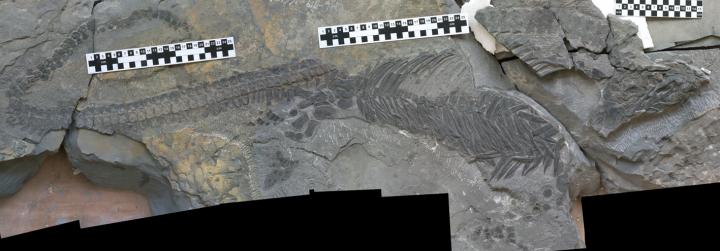Two hundred and fifty million years ago, life on earth was in a tail-spin–climate change, volcanic eruptions, and rising sea levels contributed to a mass extinction that makes the death of the dinosaurs look like child’s play. Marine life got hit hardest–96% of all marine species went extinct. For a long time, scientists believed that the early marine reptiles that came about after the mass extinction evolved slowly, but the recent discovery of a strange new fossil brings that view into question.
In a paper published in Scientific Reports, paleontologists describe a new marine reptile, Sclerocormus parviceps, an ichthyosauriform that’s breaking all the rules about what ichthyosaurs are like.
Ichthyosaurs were a massive group of marine reptiles that lived around the time of the earliest dinosaurs. Most of them looked a little bit like today’s dolphins–streamlined bodies, long beak-like snouts, and powerful tail fins. But the new species is something of a black sheep. It has a short snout (its species name even means “small skull”), and instead of a tail with triangular flukes (think of a fish’s tail-fins), it had a long, whip-like tail without big fins at the end. And while many ichthyosaurs had conical teeth for catching prey, Sclerocormus was toothless and instead seems to have used its short snout to create pressure and suck up food like a syringe. In short, it’s really different from most of its relatives, and that tells scientists something important about evolution.
“Sclerocormus tells us that ichthyosauriforms evolved and diversified rapidly at the end of the Lower Triassic period,” explains Olivier Rieppel, The Field Museum’s Rowe Family Curator of Evolutionary Biology. “We don’t have many marine reptile fossils from this period, so this specimen is important because it suggests that there’s diversity that hasn’t been uncovered yet.”
The way this new species evolved into such a different form so quickly sheds light on how evolution actually works. “Darwin’s model of evolution consists of small, gradual changes over a long period of time, and that’s not quite what we’re seeing here. These ichthyosauriforms seem to have evolved very quickly, in short bursts of lots of change, in leaps and bounds,” says Rieppel.
Animals like Sclerocormus that lived just after a mass extinction also reveal how life responds to huge environmental pressures. “We’re in a mass extinction right now, not one caused by volcanoes or meteorites, but by humans,” explains Rieppel. “So while the extinction 250 million years ago won’t tell us how to solve what’s going on today, it does bear on the evolutionary theory at work. How do we understand the recovery and rebuilding of a food chain, of an ecosystem? How does that get fixed, and what comes first?”
If our reporting has informed or inspired you, please consider making a donation. Every contribution, no matter the size, empowers us to continue delivering accurate, engaging, and trustworthy science and medical news. Independent journalism requires time, effort, and resources—your support ensures we can keep uncovering the stories that matter most to you.
Join us in making knowledge accessible and impactful. Thank you for standing with us!

